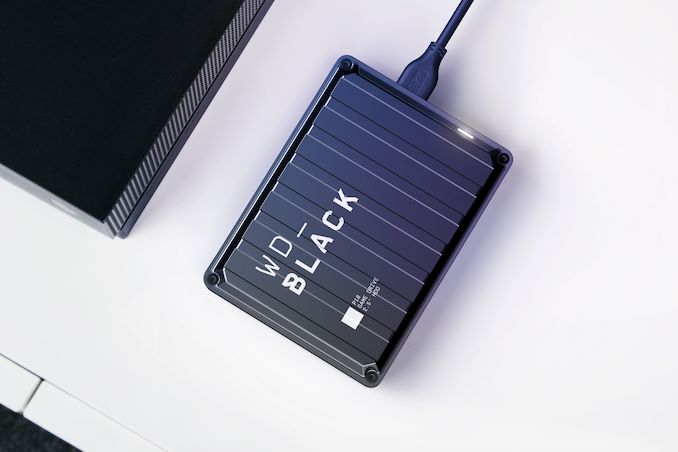Not Dead Yet: WD Releases New 6TB 2.5-Inch External Hard Drives - First Upgrade in Seven Years
by Anton Shilov on May 16, 2024 7:00 PM EST- Posted in
- Storage
- HDDs
- Western Digital
- My Passport
- External
- HDD

UPDATE 5/17, 6 PM: Western Digital has confirmed that the new 2.5-inch T GB HDDs uses 6 SMR platters
The vast majority of laptops nowadays use solid-state drives, which is why the development of new, higher-capacity 2.5-inch hard drives has all but come to a halt. Or rather, it almost has. It seems that the 2.5-inch form factor has a bit more life left in it after all, as today Western Digital has released a slate of new external storage products based on a new, high-capacity 6 TB 2.5-inch hard drive.
WD's new 6 TB spinner is being used to offer upgraded versions of the company's My Passport, Black P10, and and G-DRIVE ArmorATD portable storage products. Notably, however, WD isn't selling the bare 2.5-inch drive on a standalone basis – at least not yet – so for the time being it's entirely reserved for use in external storage.
Consequently, WD isn't publishing much about the 6 TB hard drive itself. The maximum read speed for these products is listed at 130 MB/sec – the same as WD's existing externals – and write performance goes unmentioned.
Notably, all of these 6 TB devices are thicker than their existing 5 TB counterparts, which strongly suggests that WD has increased their storage capacity not by improving their areal density, but by adding another platter to their existing drive platform (which WD has since confirmed). This, in turn, would help to explain why these new drives are being used in external storage products, as WD's 5 TB 2.5-inch drives are already 15mm thick and using 5 platters. 15mm is the highest standard thickness for a 2.5-inch form-factor, and already incompatible with a decent number of portable devices. External drives, in turn, are the only place these even thicker 2.5-inch drives would fit.
WD's specifications also gloss over whether these drives are based on shingled magnetic recording (SMR) technology. The company was already using SMR for their 5 TB drives in order to hit the necessary storage density there, and WD has since confirmed that this is exactly the case. Which is likely why the company isn't publishing write performance specifications for the drives, as we've seen device-managed SMR drives bottom out as low as 10 MB/second in our testing when the drive needs to rewrite data.
Depending on the specific drive model, all of the external storage drives use either a USB-C connector, or the very quaint USB Micro-B 3.0 connector. Though regardless of the physical connector used, all of the drives feature a USB 3.2 Gen 1 (5Gbps) electrical interface, which is more than ample given the drives' physically-limited transfer speeds.
Wrapping things up, according to WD the new drives are available at retail immediately. The WD My Passport Ultra and WD My Passport Ultra for Mac with USB-C both retail for $199.99; the WD My Passport and WD My Passport for Mac are $179.99; the WD My Passport Works With USB-C is $184.99; the gaming-focused WD_Black P10 Game Drive sells for $184.99, and the SanDisk Professional G-Drive ArmorATD is $229.99. All of Western Digital's external storage drives are backed with a three-year limited warranty.
Source: Western Digital










13 Comments
View All Comments
bananaforscale - Wednesday, May 29, 2024 - link
"External drives, in turn, are the only place these even thicker 2.5-inch drives would fit." That's not remotely true. They may not fit in laptops, but I don't have a single case where they wouldn't fit in. I actually have a 4TB CMR 2.5" drive in my gaming PC. ReplySamus - Tuesday, June 4, 2024 - link
It's worth mentioning what is happening to these drives when they bottom out is the consequence of the write algorithm. The drives I have interacted with must have some sort of OS write buffer in Windows 10\11 - even if you disable write caching and have quick removal enabled - that copies data at 500MB/sec up to about 1.2GB in size, then totally stalls down to <50MB/sec. You can hear the drive heads clanking away at what should be a smooth sequential write. I am guessing it is writing the buffer data and trying to write the remainder of the sequential file simultaneously, which as hard disks record linearly, is not ideal for performance or fragmentation. But it could have something to do with how SMR records\rearranges data...but it will do this on a brand new or freshly zeroed out (active@killdisk) or secure erased (these are SED's and support secure erase assuming you can send the command via USB I have only done it with them shucked.)It's really too bad this market was ignored. The storage industry really missed an opportunity to provide portable\convenient backup storage to the masses. There is no reason these drives should be so slow when they could increase spindle speed, add NAND cache to schedule internal writes at idle, ditch SMR and make CMR drives with just slightly less capacity (SMR doesn't actually add that much more potential storage - depending who you want to believe it is either 10%, 20% or 25% as there are conflicting configurations delivering conflicting storage metrics.) Reply
grant3 - Friday, June 7, 2024 - link
"USB Micro-B 3.0 connector" Wow WD must have a warehouse of inventory they're clearing out if they're still shipping that nonsense. Reply